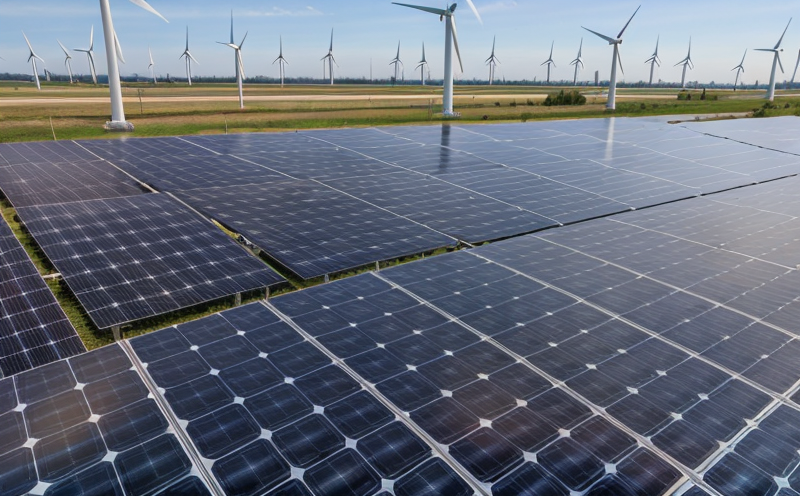CENELEC EN 50549-10 Grid Compliance Testing of Energy Resources
The CENELEC EN 50549-10 standard is pivotal in ensuring grid compliance for energy resources, particularly those integrating into smart grids and renewable stability initiatives. This standard is designed to assess the performance of distributed energy resources (DERs) under various conditions that they might encounter on the grid. It aims to ensure these resources can operate reliably and efficiently within the constraints imposed by the distribution network.
The testing encompasses a range of scenarios, including voltage deviations, frequency variations, harmonic distortions, and power quality issues. These tests are essential for verifying that DERs meet technical requirements set forth in this standard, ensuring they do not disrupt grid stability or performance. The compliance testing also evaluates how the energy resource behaves under extreme conditions such as fault events, islanding scenarios, and reactive power compensation.
For R&D engineers and quality managers, understanding these tests is crucial for meeting regulatory standards and enhancing product reliability. Compliance with CENELEC EN 50549-10 can significantly impact a company's reputation in the renewable energy sector, especially when aiming to penetrate competitive markets or secure international certifications.
The testing protocol involves detailed procedures for specimen preparation, which includes simulating real-world conditions through controlled environments and scenarios. The instrumentation used during these tests is state-of-the-art, designed to replicate grid parameters accurately. This ensures that the results are reliable and can be trusted by regulatory bodies and other stakeholders.
Compliance with CENELEC EN 50549-10 is not just a compliance requirement; it is an investment in product quality and market credibility. By adhering to this standard, manufacturers ensure their products meet the highest industry standards, thereby enhancing consumer trust and fostering a positive brand image.
The acceptance criteria for CENELEC EN 50549-10 are stringent and designed to protect both the grid infrastructure and end-users. These criteria include performance under steady-state conditions as well as transient events. The testing process ensures that energy resources can withstand these challenges without causing harm or disruption.
In summary, CENELEC EN 50549-10 is a critical standard for ensuring grid compliance of energy resources. It plays a vital role in the integration of renewable energy into smart grids and enhancing overall system stability. For companies involved in this sector, mastering these tests is essential for successful market entry and long-term sustainability.
Why It Matters
The importance of CENELEC EN 50549-10 cannot be overstated, especially as the global focus shifts towards renewable energy integration. This standard ensures that distributed energy resources (DERs) can seamlessly integrate into smart grids without causing instability or operational issues.
- Enhanced Grid Reliability: By ensuring DERs meet stringent performance criteria under various conditions, this standard enhances overall grid reliability and stability.
- Consumer Trust: Compliance with this standard builds trust among consumers who rely on a stable and reliable power supply.
- Market Access: Meeting these standards opens up new market opportunities by demonstrating commitment to quality and compliance.
The need for grid compliance testing is driven by the increasing complexity of modern energy systems. As more renewable resources are added to the grid, it becomes essential to ensure they can operate safely and effectively alongside traditional power sources. This standard provides a framework for achieving that goal.
For quality managers and compliance officers, understanding the nuances of CENELEC EN 50549-10 is crucial. It ensures that products meet not only regulatory requirements but also exceed them, positioning companies as leaders in their field.
Environmental and Sustainability Contributions
The integration of renewable energy resources into smart grids through CENELEC EN 50549-10 testing contributes significantly to environmental sustainability. By ensuring that these resources can operate reliably within the constraints of the grid, this standard helps reduce emissions and promotes a greener future.
One key aspect is minimizing the environmental impact during operation. The tests conducted under CENELEC EN 50549-10 ensure that energy resources are designed to be efficient and effective, thereby reducing waste and resource consumption. This aligns with broader sustainability goals, such as reducing carbon footprints and promoting sustainable development.
In addition to operational efficiency, the standard also supports long-term environmental benefits by fostering innovation in renewable technologies. Companies that comply with this standard often invest in cutting-edge research and development, leading to more advanced and environmentally friendly solutions.
The testing process itself is conducted with a focus on minimizing waste and maximizing energy efficiency. This includes optimizing specimen preparation and using the latest instrumentation to ensure accurate results. By doing so, laboratories adhering to CENELEC EN 50549-10 contribute positively to environmental sustainability.
In conclusion, compliance with CENELEC EN 50549-10 not only ensures grid stability but also promotes a more sustainable and efficient energy future.
Competitive Advantage and Market Impact
- Innovation Leadership: Compliance with CENELEC EN 50549-10 positions companies as leaders in renewable energy integration, setting them apart from competitors who may not meet these standards.
- Better Product Reputation: Meeting this standard enhances the reputation of products, making them more desirable to consumers and partners alike.
- Increased Market Opportunities: Companies that comply with CENELEC EN 50549-10 can access new markets and secure international certifications, expanding their business horizons.
- Enhanced Consumer Trust: By ensuring grid reliability and stability, compliance builds trust among consumers who rely on a stable power supply.
In conclusion, CENELEC EN 50549-10 is not just a technical standard; it is a strategic tool for companies in the renewable energy sector. It provides a competitive edge by fostering innovation and enhancing product reliability, ultimately leading to increased market opportunities and consumer trust.





